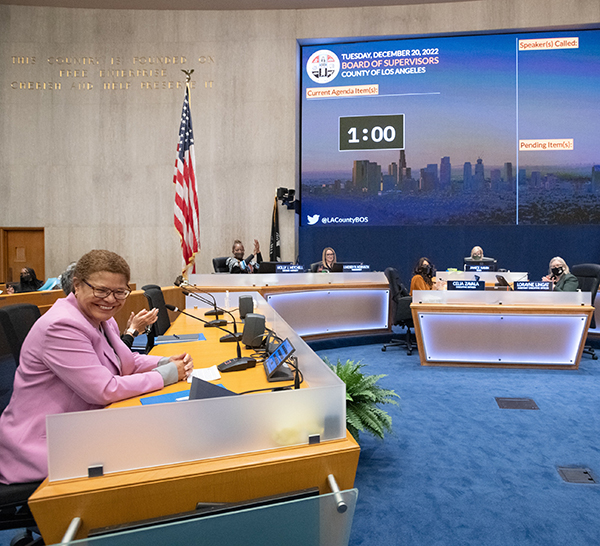An aerial view shows the devastation left by the Eaton Fire last January in Altadena. A report issued last week on the response to the fire. The report failed to place any blame on the lateness of evacuation orders in West Altadena.
Courtesy photo
Wave Wire Services
ALTADENA — Standing near the site of a destroyed home Sept. 30, a group of fire-impacted Altadenans and local organizations called on state Attorney General Rob Bonta to investigate Los Angeles County’s response to January’s Eaton Fire, including delays in evacuation orders being issued to residents in the western Altadena area.
The group, Altadena for Accountability, urged Bonta to “compel testimony, examine withheld data and records and hold public agencies accountable for their failures before, during and after the fire.”
The move comes in the wake of the county-commissioned “Independent After-Action Report” by the McChrystal Group that identified systemic failures in emergency notification and evacuation order procedures during the January fires.
“It shouldn’t be controversial to insist that we have an honest independent commission to examine the issues that wiped out this entire town and killed 20 people,” Cora Bella, an Altadena fire survivor, said.
According to the community group, the McChrystal report failed to answer key questions on evacuation notifications, disparities in firefighter presence in historically Black western Altadena, and process breakdowns by the sheriff and fire departments.
Gina Clayton Johnson, a fire survivor, said “there is a history of failures here.” She described the report as bending over backwards to “shield any decision maker or agency from accountability.”
“Los Angeles County promised the report would provide a clear, fact-based review of how alerts, warnings, and evacuations were handled,” Shawna Dawson Beer, an organizer with the Beautiful Altadena Community and a total loss fire survivor, said in statement. “Instead, the McChrystal Group’s After-Action Report is a carefully, conveniently worded PR spin, tip-toeing around county missteps, assigning responsibility nowhere in particular, and worse, pointing fingers at fire victims.
“The report confirms what we already knew — there was no plan,” Dawson Beer added.
Fire survivors fear that due to “inadequacies” of the report, the next emergency could be worse.
“McChrystal Group’s repeated blatant misuse of the term ‘perfect storm’ to describe the Eaton Fire is both dishonest and strategic,” Lauren Randolph, a total loss fire survivor, said in a statement.
Bonta’s office did not immediately respond to a request for comment.
While the press conference was going on, the county Board of Supervisors held an hours-long discussion of the after-action report.
During that discussion, Supervisor Kathryn Barger — who represents the Altadena area — acknowledged that the report “has generated some anger” for not placing specific blame on any single reason for delays in evacuation orders.
“To our survivors, I wish there were a single point of failure we could point to,” Barger said.
But she also expressed frustration with what she called omissions in the report, including details about the delay in evacuation orders despite 911 calls coming from western Altadena.
The report stressed that investigators found “no single point of failure” relating to public alerts, warnings and notifications.
“Instead, a series of weaknesses, including outdated policies, inconsistent practices and communications vulnerabilities impacted the system’s effectiveness,” according to the report. “These systemic issues did not manifest uniformly across the two major fires. The effects of these weaknesses varied based on environmental conditions, community readiness and operational complexity caused by the variables of wind, power outages and fire behavior.”
The wildfires killed 31 people and destroyed 16,251 properties in Altadena and Pacific Palisades, along with parts of Los Angeles, Pasadena, Sierra Madre and Malibu.
Supervisors grilled representatives of the McChrystal Group, along with Sheriff Robert Luna, county Fire Chief Anthony Marrone and Office of Emergency Management Director Kevin McGowan about specific issues cited in the report and efforts to rectify problems.
Barger became visibly angry during the discussion, noting that while county agencies cooperated fully with the McChrystal investigation, some other law enforcement declined to be interviewed or provide emergency-response information.
“To me it is inexcusable and I would challenge any one of those departments or any one of those chiefs to explain why [they did not participate],” Barger said, adding that she was “incredibly frustrated and disappointed.”
Barger asked repeatedly about the law enforcement and fire response in the western Altadena area, where evacuation orders were not issued until roughly 3:25 a.m. Jan. 8, hours after spot fires were being reported in the area.
Marrone acknowledged that fire personnel and commanders were “severely challenged” due to the number of blazes that were raging during the unprecedented windstorm, and it took time to verify the path and status of the fast-moving fire, delaying the process of issuing an evacuation order.
But the fire chief strongly denied suggestions that there was only one fire truck in the western Altadena area, or that firefighters were “sitting idle” as the conflagration raged.
“We had resources including other fire agencies and law enforcement partners performing evacuations and rescues throughout the night, well ahead of the evacuation order that came at 3:25 (a.m.),” Marrone said.
He added that there were 20 different fire departments in the Altadena area offering mutual aid, at the time, but some of those agencies declined to be interviewed by the McChrystal investigators, so there was no detailed accounting of those deployments.
Luna also insisted that sheriff’s deputies were in the western Altadena area urging residents to leave, even before evacuation orders were issued.
Some Altadena residents attending the meeting, however, disputed those contentions, saying they didn’t see any emergency responders in the area for hours.
Horvath, who represents that Palisades Fire area, became visibly emotional as she complained about what she called omissions in the report, such as any discussion about an evacuation alert that was intended for residents in the San Fernando Valley but was mistakenly sent countywide amid the various fires. She also said the report should have included more personal input from fire survivors and their experiences.
Horvath also questioned the report’s suggestion that many residents aren’t fully educated about Public Safety Power Shutoffs that often occur during wildfire conditions — insisting that Pacific Palisades residents were fully aware of the program, having lived through it during multiple previous wildfires.
The report’s authors outlined key differences in the Palisades and Eaton fires, noting that the Palisades blaze erupted during daylight hours in a community that was familiar with wildfire risks. The Eaton Fire, however, occurred at night in an area not traditionally associated with severe wildfire danger.
At the end the discussion Sept. 30, the board unanimously approved a joint motion by Barger and Horvath asking for an immediate start to implementation of recommendations in the report, with update reports presented to the board every 60 days. The motion also called on county staff to report back in two months on the possibility of increasing the size of the county’s Office of Emergency Management, and moving it into a stand-alone department rather than operating within the county executive office.
U.S. Rep. Judy Chu, D-Pasadena, sent a letter to the board encouraging the county to implement reforms as detailed in the after-action report.
The report confirmed that while residents east of Lake Avenue in Altadena were told to evacuate as early as 7:26 p.m., residents west of Lake Avenue — where 18 of the 19 deaths occurred — did not receive an evacuation alert until 3:25 a.m., hours after the first 911 calls from the area, according to Chu’s office.
“We owe it to the victims, survivors, and their families to ensure that these evacuation delays and failures are never repeated,” Chu said in a statement.
Shawn Tyrie of the McChrystal Group noted during a news conference last week that the county’s Office of Emergency Management has only 37 staff members — in a county of 10 million residents. He said by comparison, New York City has 200 such workers for an area smaller in both size and population.
Tyrie said the report includes recommendations in five primary areas, relating to:
• Ambiguity in authority for issuing emergency alerts.
• Training and staffing guidelines to improve emergency response.
• Resource and staffing shortfalls in the emergency management system.
• The lack of coordinated tools and systems to coordinate communications among first responder and emergency management personnel.
• And fragmented community engagement and public information procedures.




